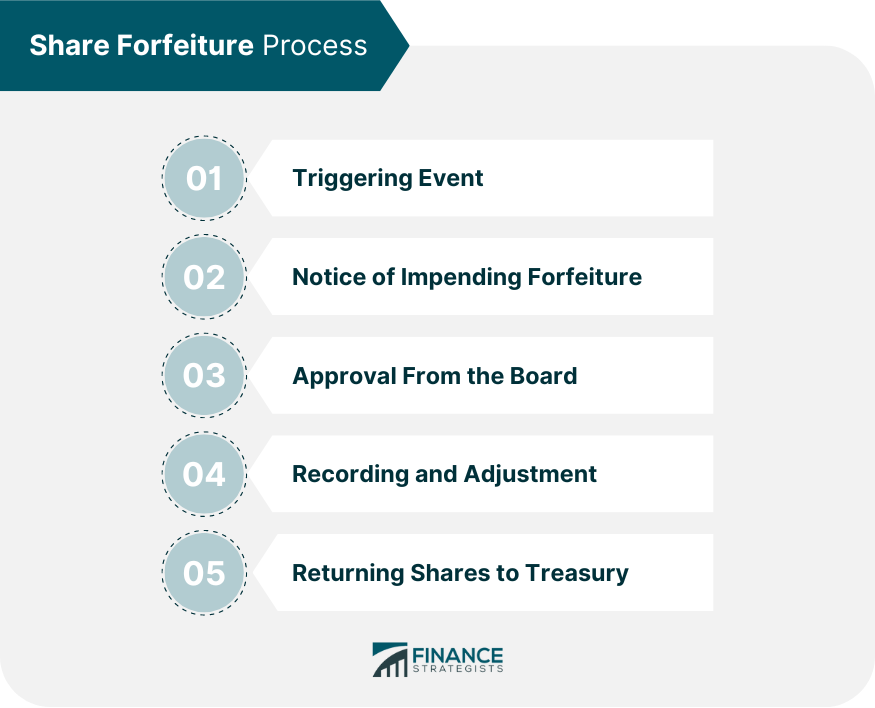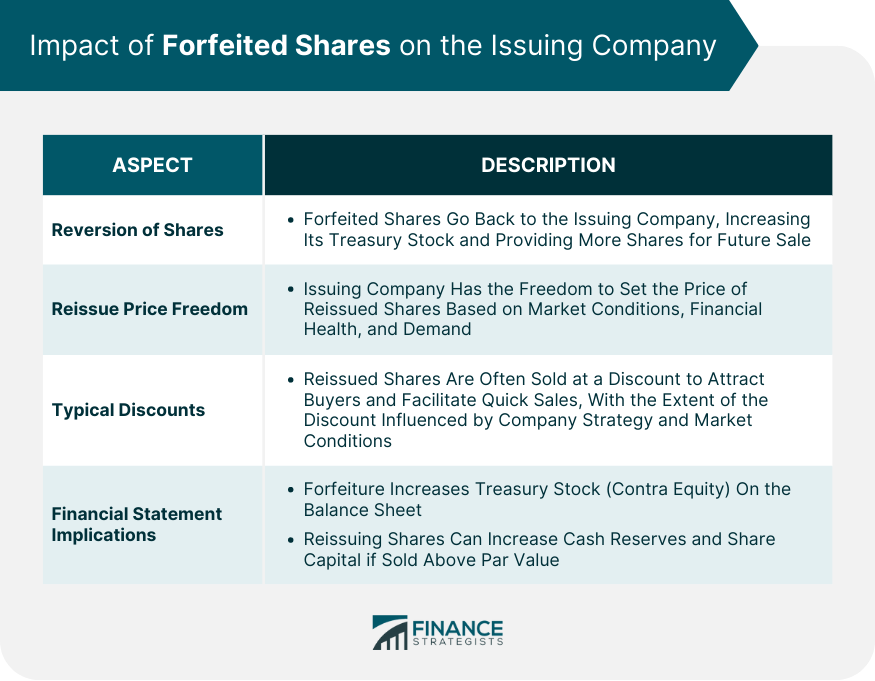Forfeited shares refer to shares in publicly-traded companies that a shareholder relinquishes due to failure to comply with certain purchase agreements or restrictions. This forfeiture implies the shareholder loses the opportunity to derive any potential gain from the shares. However, it also means that the shareholder no longer owes any remaining balance associated with the shares. Share forfeiture is not a routine event. It happens under particular circumstances when a shareholder fails to honor the obligations tied to the shares. Such obligations may range from payment deadlines to contractual agreements. Moreover, forfeiture can occur when an employee leaves a company before their stock options have vested fully. In such cases, the company repossesses the shares, effectively making them forfeited shares. Shares can be forfeited when a shareholder fails to meet the terms of the purchase agreement. Such an agreement often stipulates a payment schedule that a shareholder must adhere to. When the shareholder is unable to meet these payment obligations, the company has the right to reclaim the shares. Shareholders might be subject to certain restrictions based on the shareholder agreement or company policy. For instance, a company may prohibit selling shares within a certain period. If a shareholder violates these restrictions, their shares may be forfeited. Employees often receive stock options as part of their compensation. These options typically have a vesting period, during which the employee must remain with the company. If the employee resigns or is terminated before this period ends, they may forfeit their unvested stock options. Upon forfeiture of shares, the shareholder is relieved from any remaining balance that they owe on the shares. This aspect may provide some financial relief to the shareholder, especially if they are struggling to meet their payment obligations. However, forfeiting shares also means that the shareholder misses out on potential gains. If the company's stock price were to rise, the shareholder would not benefit from this increase. Hence, forfeiture comes with the opportunity cost of lost profits. The entire process of share forfeiture begins with a triggering event. This typically involves an action or omission on the part of the shareholder that is against the company's rules or contractual agreements. A common example of such an event is a failure to meet payment obligations. When a shareholder purchases shares on call, they are expected to make payments by a certain date. If they fail to do so, this non-payment could potentially trigger the forfeiture process. Another triggering event could be the breach of certain restrictions that the shareholder agreed to upon purchasing the shares. Once the triggering event has occurred, the company then takes its first formal step toward forfeiture. This involves issuing a notice to the shareholder, informing them of the impending forfeiture. The notice provides the shareholder with the details of their breach or failure, as well as a period within which they must rectify the situation. The company also lays out the consequences of non-compliance, namely the forfeiture of their shares. If the shareholder fails to rectify the situation within the stipulated period, the company moves on to the next step in the forfeiture process. Before the company can proceed with the forfeiture, the decision usually needs to be approved by the company's board of directors. This approval ensures that the process is transparent and is being conducted in the best interest of the company. Once the forfeiture is approved by the board of directors, the company proceeds to record the forfeiture. This is a critical step, as it involves adjusting the company's financial records accordingly. The forfeiture needs to be accurately reflected in the company's books to ensure that its financial statements remain accurate and compliant with regulations. The final step in the share forfeiture process involves returning the forfeited shares to the company's treasury. The shares once held by the defaulting shareholder now become part of the company's treasury stock. These shares do not vanish, but rather, they can be reissued or resold by the company in the future. This allows the company to potentially recover any losses incurred due to the shareholder's non-compliance, thereby ensuring that the company's financial health remains stable. When shares are forfeited, they revert to the issuing company. This reversion increases the company's treasury stock, effectively giving the company more shares to sell in the future. The company regains full control over these shares, allowing it to decide when and how to reissue them. The issuing company has the freedom to set the reissue price of forfeited shares. The price may depend on various factors, such as current market conditions, the company's financial health, and demand for the shares. Typically, companies reissue forfeited shares at a discount to the initial price. This discount serves as an incentive for potential buyers and can help the company quickly sell the shares. However, the extent of the discount depends on the company's strategy and market conditions. Share forfeiture and subsequent reissue can have several implications for a company's financial statements. The forfeiture increases the company's treasury stock, which is recorded as a contra-equity account on the balance sheet. The reissue of shares, on the other hand, can increase the company's cash reserves and share capital, assuming the shares are sold at a price higher than their par value. Shareholders can take several actions to prevent forfeiture. These include meeting all payment obligations on time, complying with any restrictions on the shares, and carefully considering the terms of stock options and their associated vesting periods. Companies can also implement policies to minimize the risk of share forfeiture. These may include flexible payment schedules, clear communication of share restrictions, and vesting schedules that incentivize employee retention. Forfeited shares, a relatively intricate concept in the realm of corporate finance, occur when a shareholder fails to fulfill certain purchase agreements or restrictions. These could stem from a failure to meet payment obligations, breaching share-related restrictions, or an employee exiting the company before their stock options fully vest. The process of share forfeiture involves the company, which monitors compliance and maintains accurate records of all transactions, including forfeitures. Prevention of share forfeiture primarily lies in the hands of the shareholder, who must ensure adherence to all terms and conditions associated with the shares. Moreover, companies can also adopt policies that minimize the risk of share forfeitures, such as clear communication of share restrictions and flexible payment schedules. Given the potential financial implications of share forfeiture, it's advisable for shareholders to seek professional wealth management services. These experts can provide guidance on navigating complex financial situations, including understanding the terms and conditions of share purchases and how to manage stock options effectively.What Are Forfeited Shares?
Understanding Share Forfeiture
Reasons for Forfeiture
Failing to Meet Purchase Agreements
Breaching Restrictions
Resignation or Termination Before Stock Options Vest

Implications for the Shareholder
Release From Any Remaining Balance Owed
Loss of Potential Gain on the Shares
Process of Share Forfeiture
Triggering Event
Notice of Impending Forfeiture
Approval From the Board of Directors
Recording the Forfeiture and Adjusting the Books
Returning Shares to the Treasury

Impact on the Issuing Company
Reversion of Shares to the Issuing Company
Reissue of Forfeited Shares
Freedom to Set Reissue Price
Typical Discounts on Reissued Shares
Implications for the Company's Financial Statements

Prevention and Mitigation Strategies of Forfeited Shares
Shareholder Actions to Prevent Forfeiture
Company Policies to Minimize Risk of Forfeiture
Final Thoughts
Forfeited Shares FAQs
A forfeited share refers to shares in a publicly-traded company that a shareholder relinquishes due to failure to meet certain purchase agreements or restrictions. Once forfeited, these shares revert back to the company, and the shareholder no longer owes any remaining balance.
Shares can be forfeited due to various reasons, including failure to meet payment obligations stipulated in the purchase agreement, breaching restrictions placed on the shares, or an employee leaving the company before their granted stock options have fully vested.
When shares are forfeited, they revert back to the company, and it can decide to reissue these shares at a price of its choosing, typically at a discount. The company's financial statements will reflect these changes, particularly in the treasury stock, cash reserves, and share capital accounts.
Prevention of share forfeiture involves meeting all payment obligations on time, adhering to restrictions on the shares, and understanding the terms of stock options and their associated vesting periods. Companies can also minimize the risk of forfeiture through policies such as flexible payment schedules and clear communication of share restrictions.
For shareholders, forfeiting shares means missing out on potential gains if the company's stock price rises. It also relieves them from any remaining balance owed on the shares. For the company, forfeiture can provide an opportunity to raise additional capital through the reissue of shares. However, it might also indicate financial instability, potentially affecting the company's reputation.
True Tamplin is a published author, public speaker, CEO of UpDigital, and founder of Finance Strategists.
True is a Certified Educator in Personal Finance (CEPF®), author of The Handy Financial Ratios Guide, a member of the Society for Advancing Business Editing and Writing, contributes to his financial education site, Finance Strategists, and has spoken to various financial communities such as the CFA Institute, as well as university students like his Alma mater, Biola University, where he received a bachelor of science in business and data analytics.
To learn more about True, visit his personal website or view his author profiles on Amazon, Nasdaq and Forbes.















